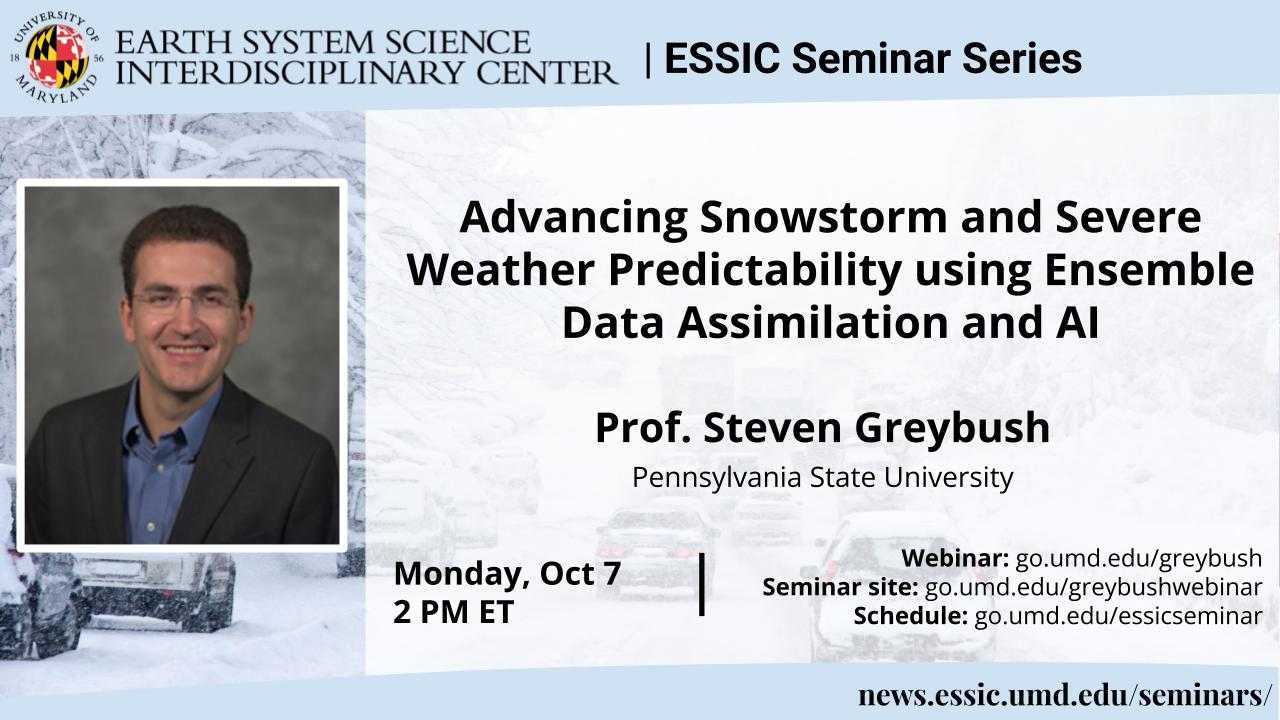
Advancing Snowstorm and Severe Weather Predictability using Ensemble Data Assimilation and AI
Prof. Steven Greybush
Pennsylvania State University
Monday October 7, 2024, 2 PM ET
Abstract:
Winter storms remain a prediction challenge, from the synoptic-scale evolution of the associated mid-latitude cyclone to the formation, location, and intensity of mesoscale snowbands, to microphysics and the transitions in precipitation type, to terrain- enhanced and lake-effect processes. The recent NASA IMPACTS field campaign, with two coordinated aircraft as well as ground observations across field operations in 2020, 2022, and 2023, provides an unprecedented dataset with which to evaluate winter storm simulations. In order to analyze the practical predictability of east coast winter storms, operational models, AI models, as well as convection-allowing ensemble WRF simulations that assimilate conventional and field campaign observations are assessed for several cases during the IMPACTS period. Analyzing the predictability of NWP model simulations gives insights to the growth of forecast errors and the underlying dynamical mechanisms for these extreme events. Comparisons between simulations, conventional surface and radar observations, as well as field campaign observations are conducted.
Likewise, anticipating the timing and location of convection initiation, which can lead to severe thunderstorms, remains a challenge for both numerical modeling and observations-based approaches. A convection initiation nowcasting system using deep learning applied to GOES-16 IR satellite observations is developed. Trained on convection initiation events identified from radar images, with a storm tracking algorithm used to separate pre-existing from new convection, the technique demonstrates superior performance to a baseline logistic regression model, demonstrating that the technique can successfully use spatially encoded information in the satellite predictors. Explainable AI techniques enable the contribution of specific features in the satellite channels toward the prediction to be assessed, giving insights to important physical processes. Finally, ensemble-based deep learning techniques can help quantify the uncertainty of predictions.
Biosketch:
Dr. Steven J. Greybush is an Associate Professor in the Department of Meteorology and Atmospheric Science and a Co-Hire of the Institute of Computational and Data Sciences (ICDS) at the Pennsylvania State University. His research applies computational techniques such as computer simulations, data assimilation, ensembles, and machine learning to studying the weather of the earth and Mars, from snowstorms and other extreme weather to dust storms. He obtained his undergraduate degrees in meteorology and computer science from Penn State, and an M.S. and Ph.D. in Atmospheric and Oceanic Science from the University of Maryland. His team produced the first ensemble reanalysis of the Martian atmosphere, which provides hourly maps of temperatures, wind, surface pressure, and dust across Mars for a period of over a decade. He leads the executive team for the Penn State Center for Advanced Data Assimilation and Predictability Techniques (ADAPT), and is a member of the multi-university Consortium for Advanced Data Assimilation Research and Education (CADRE).
Webinar:
Event site: https://go.umd.edu/greybush
Zoom Webinar: https://go.umd.edu/greybushwebinar
Zoom Meeting ID: 952 3603 5498
Zoom password: essic
US Toll: +13017158592
Global call-in numbers: https://umd.zoom.us/u/aMElEpvNu
For IT assistance:
Cazzy Medley: cazzy@umd.edu
Resources:
Seminar schedule & archive: https://go.umd.edu/essicseminar
Seminar Google calendar: https://go.umd.edu/essicseminarcalendar
Seminar recordings on Youtube: https://www.youtube.com/user/ESSICUMD

